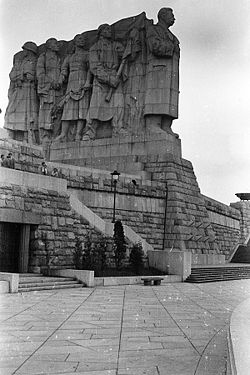
Otakar Švec
Encyclopedia

Stalin's Monument (Prague)
Stalin's Monument was a massive granite statue honoring Joseph Stalin that was unveiled in 1955 after more than 5½ years of work in Prague, Czech Republic. It was the world's largest representation of Stalin, and was destroyed in 1962....
in Prague
Prague
Prague is the capital and largest city of the Czech Republic. Situated in the north-west of the country on the Vltava river, the city is home to about 1.3 million people, while its metropolitan area is estimated to have a population of over 2.3 million...
, Czech Republic
Czech Republic
The Czech Republic is a landlocked country in Central Europe. The country is bordered by Poland to the northeast, Slovakia to the east, Austria to the south, and Germany to the west and northwest....
.
A pupil of Josef Václav Myslbek
Josef Václav Myslbek
Josef Václav Myslbek was a Czech sculptor credited for founding of the modern Czech sculpting style.Josef grew up poor in a suburb of Prague. His family pushed him to become a shoemaker but he shirked the duty by getting a job with a succession of Czech sculptors...
and Jan Štursa
Jan Štursa
Jan Štursa was a Czech sculptor, one of founders of modern Czech sculpture.- Birth and studies :...
, Švec had produced the important 1924 Futurist
Futurism (art)
Futurism was an artistic and social movement that originated in Italy in the early 20th century. It emphasized and glorified themes associated with contemporary concepts of the future, including speed, technology, youth and violence, and objects such as the car, the airplane and the industrial city...
sculpture Sunbeam Motorcycle, now in the National Gallery in Prague
National Gallery in Prague
The National Gallery in Prague is a state-owned art gallery in Prague, Czech Republic. It is housed in different locations within the city, the largest being the Veletržní Palác....
, and at least three major public monuments to Tomáš Masaryk
Tomáš Masaryk
Tomáš Garrigue Masaryk , sometimes called Thomas Masaryk in English, was an Austro-Hungarian and Czechoslovak politician, sociologist and philosopher, who as an eager advocate of Czechoslovak independence during World War I became the founder and first President of Czechoslovakia, also was...
, Jan Hus
Jan Hus
Jan Hus , often referred to in English as John Hus or John Huss, was a Czech priest, philosopher, reformer, and master at Charles University in Prague...
, and Franklin Delano Roosevelt. The first two were destroyed by the Germans during World War II
World War II
World War II, or the Second World War , was a global conflict lasting from 1939 to 1945, involving most of the world's nations—including all of the great powers—eventually forming two opposing military alliances: the Allies and the Axis...
, and the other by the Soviet occupation.
Švec entered the competition for the Stalin Monument assuming that it was politically fixed, and he hoped only for second prize. Švec won, and the political pressures of the job destroyed him. The sculpture was unveiled on May Day, 1955, but Švec had killed himself by kitchen gas three weeks earlier, following the example of his wife. This world's largest representation of Stalin, dominating the city, stood for only seven years before the political climate changed. It was brought down in October 1962 with 800 kilograms of dynamite
Dynamite
Dynamite is an explosive material based on nitroglycerin, initially using diatomaceous earth , or another absorbent substance such as powdered shells, clay, sawdust, or wood pulp. Dynamites using organic materials such as sawdust are less stable and such use has been generally discontinued...
.
Sources
- Figuration/Abstraction: Strategies for Public Sculpture in Europe 1945-1968, by Charlotte Benton
- source on a recent show of Švec's work

